How to Cook Pork Braciole in the Oven

A traditional Italian recipe but with a southern twist, this Pork Braciole is fork-tender medallions of pork tenderloin wrapped around cornbread and pecan stuffing and simmered in a flavorful homemade marinara sauce.
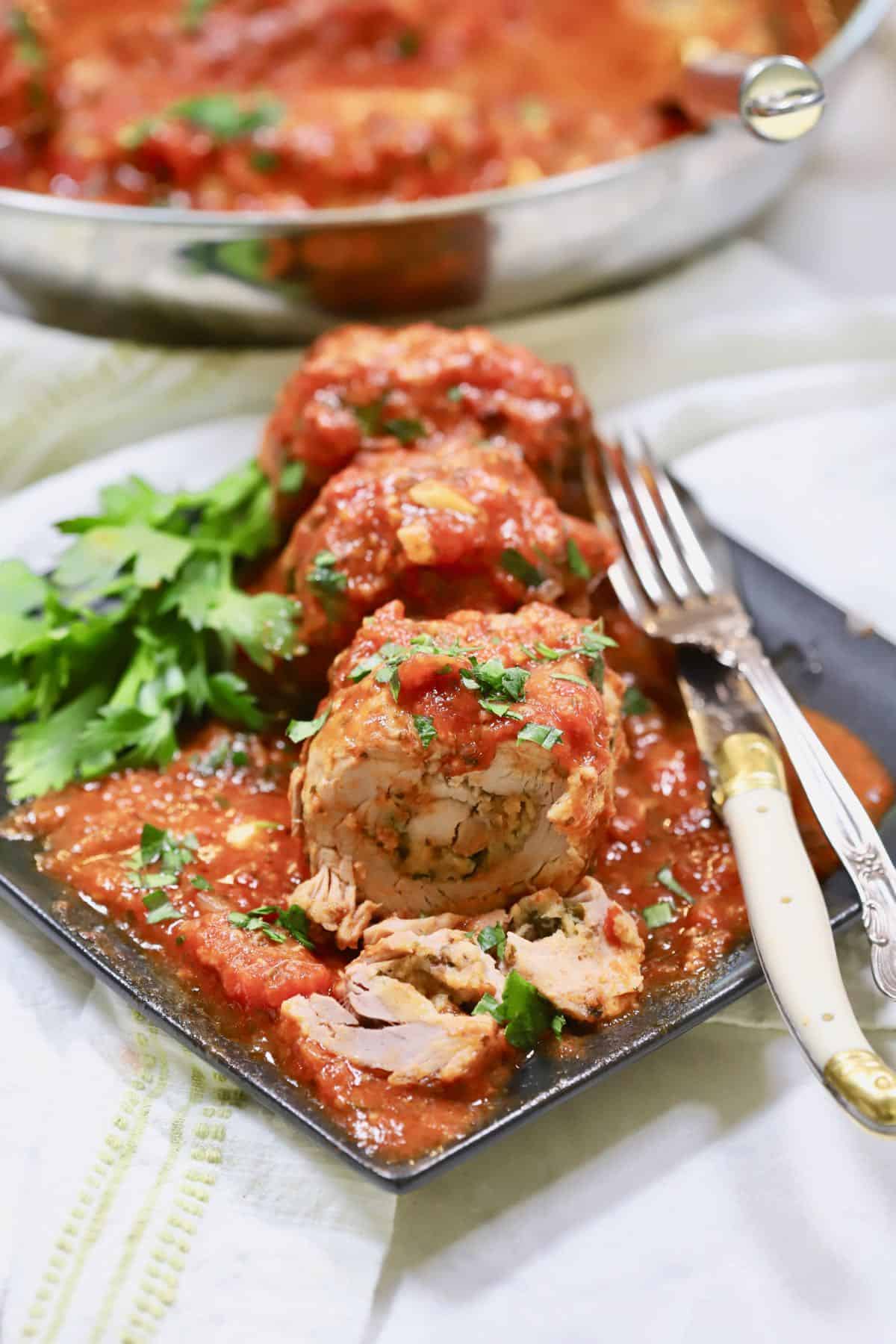
My southern twist is to substitute crumbled cornbread for the bread crumbs and add a handful of roasted pecans to the stuffing mix, and I've substituted white wine for the traditional red. And while this recipe has a few more ingredients and more steps than most of my recipes, it is simple to prepare.
Braciole pork is the epitome of comfort food and is perfect for a Sunday family dinner. Because it makes a beautiful presentation and can be made ahead, it's also perfect for a dinner party.
What it is:
A classic Italian dish from the southern part of Italy, braciole is thin slices of meat wrapped around a filling typically made with bread crumbs, cheese, and sometimes meat, and cooked in a wine and tomato sauce.
Here's what you will need:
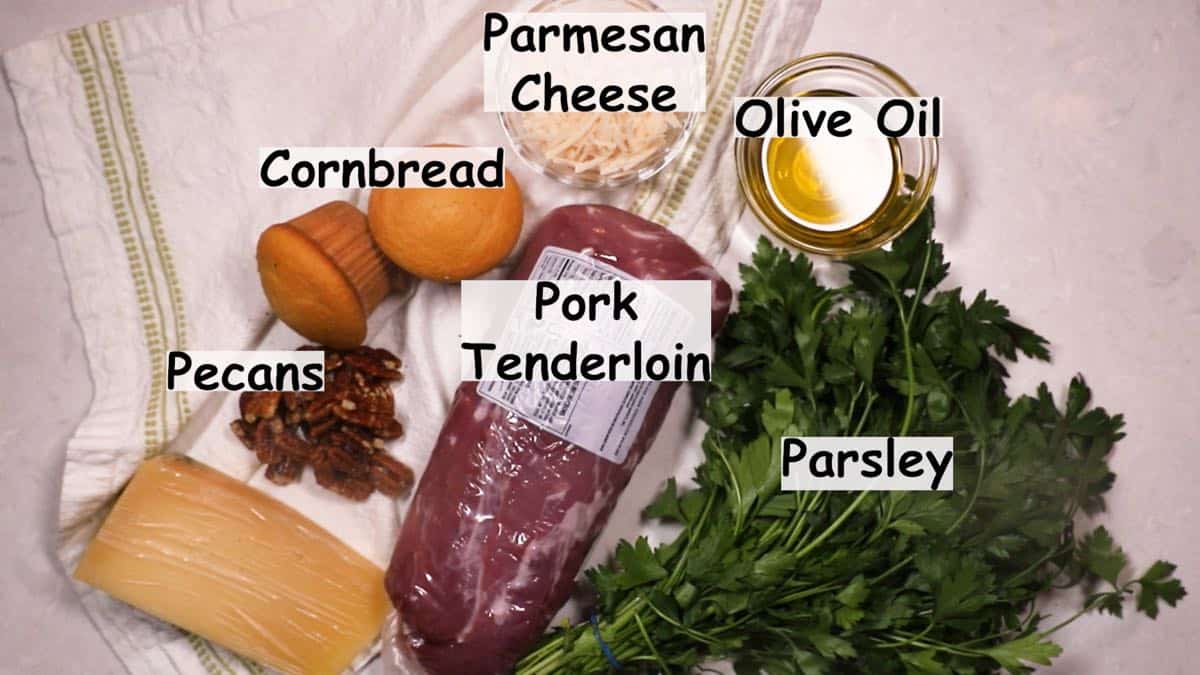
- Pork tenderloin: a lean and tender cut of meat that runs along the backbone. It can be a little expensive, but there is no waste, and it works perfectly in this recipe.
- All-Purpose flour: used to dredge the pork rolls in before browning and slightly thickens the marinara sauce.
- Olive oil: save the extra virgin olive oil and use pure or regular olive oil for cooking. Besides being less expensive, it has a higher smoke point.
- Cornbread: one of the southern components of this recipe; you can make your own or use purchased corn muffins as I sometimes do. And while I don't usually recommend sweetened cornbread, it works fine in this recipe.
- Parmesan cheese: a traditional ingredient in pork braciole. You can also substitute Parmigiano Reggiano or Romano.
- Pecans: another non-traditional southern component. Roasted pecans add a nutty buttery touch that blends well with the cornbread in the stuffing.
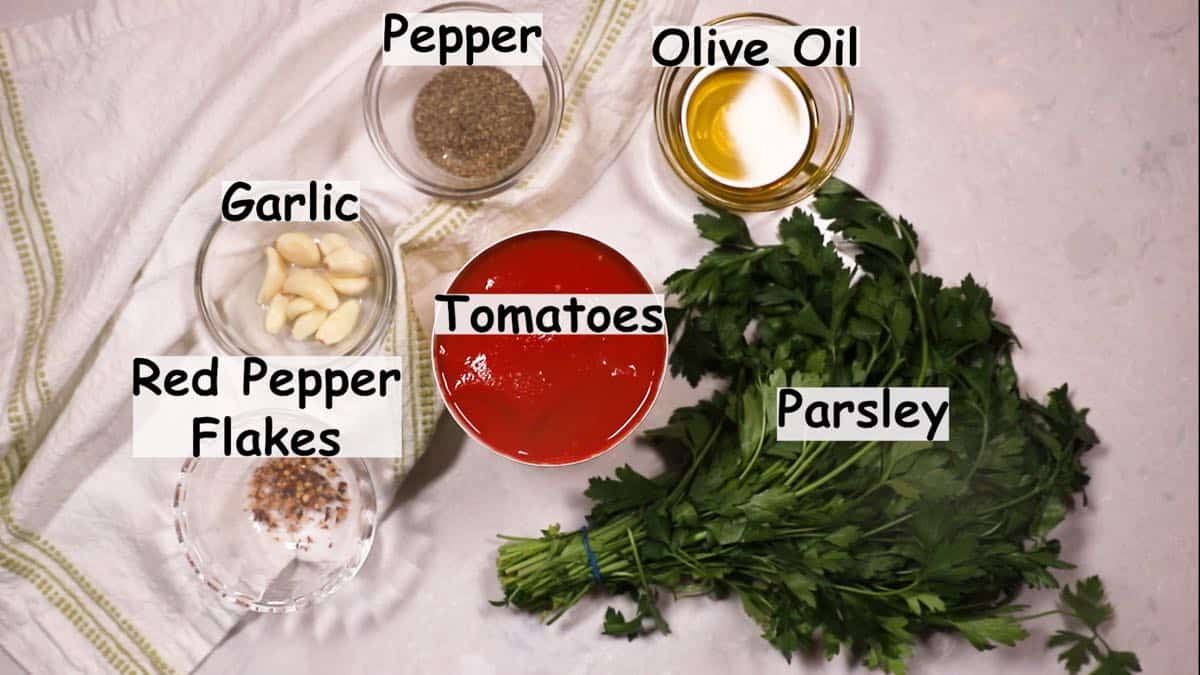
- San Marzano tomatoes: a variety of canned plum or Roma tomatoes. They have to be grown in San Marzano sul Sarno, near Naples, to be certified as true San Marzano tomatoes. These tomatoes are a little sweeter and not quite as acidic as regular canned tomatoes. If you use regular canned tomatoes, you might want to add a teaspoon or so of sugar to your sauce.
- Garlic and onions: the marinara sauce's flavor base adds a slight touch of rich sweetness.
- White wine: use a good dry white wine and one that you would drink to add a rich, savory element to this dish. I usually use chardonnay. Don't use cooking wine. If you don't want to add wine, you can substitute chicken stock and if you prefer red, by all means, use it instead.
- Seasonings and spices: Kosher salt, ground black pepper, dried parsley flakes, dried basil, and red pepper flakes all do their part to enhance the taste of this dish. If you use fresh herbs, be sure to double the amount called for, and if you use regular table salt instead of Kosher, only use half as much.
Here's how to make it:
Cut the pork tenderloins into eight equal pieces.
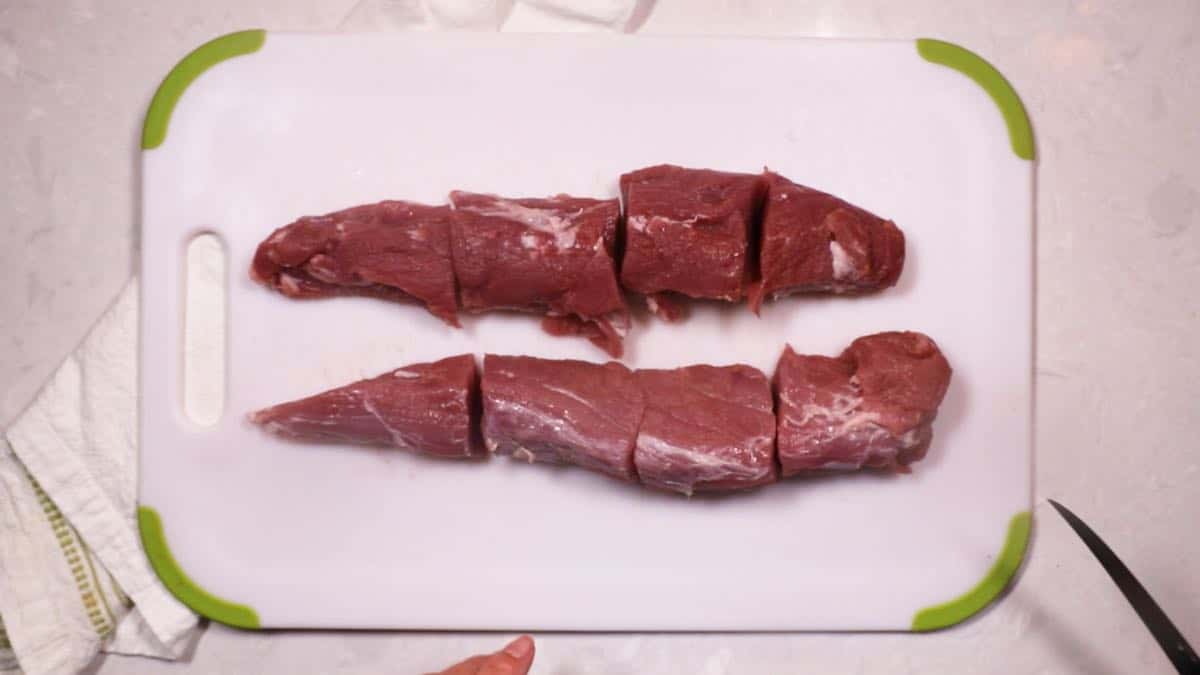
Place each piece in a plastic storage bag and use a meat mallet or rolling pin to gently pound each piece to a 1/4-inch thickness. Set aside.
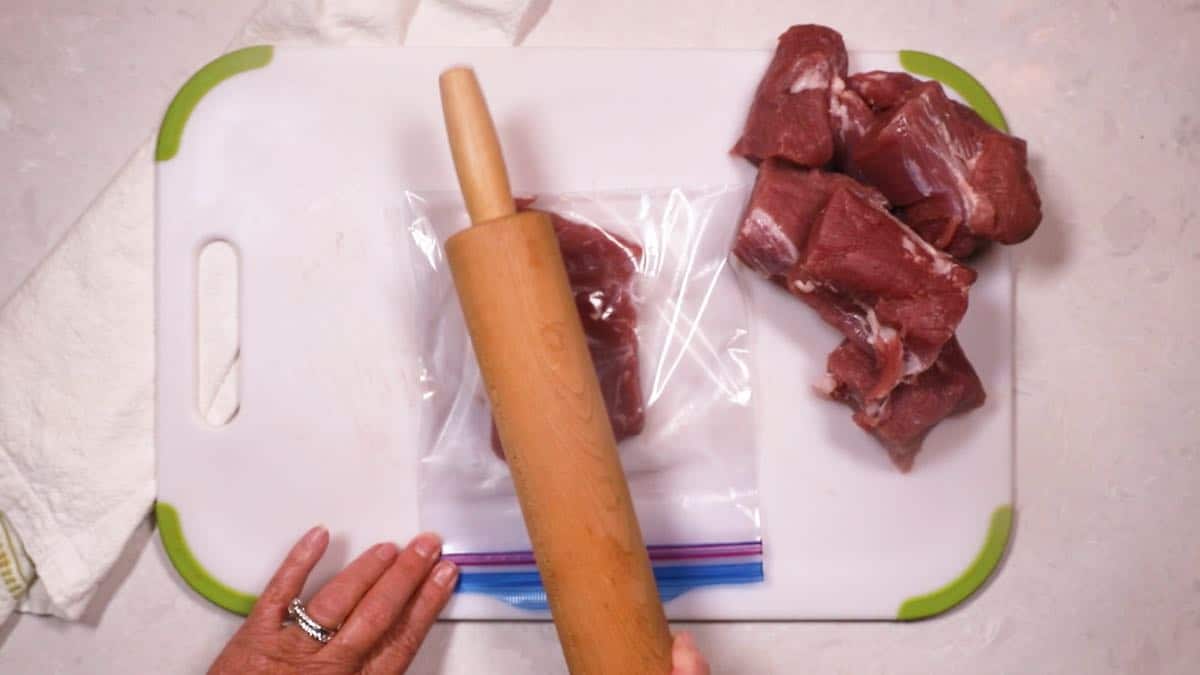
To make the stuffing, crumble the cornbread and place in a medium-size bowl. Add the parmesan, parsley, garlic, salt, pecans, and olive oil and combine.
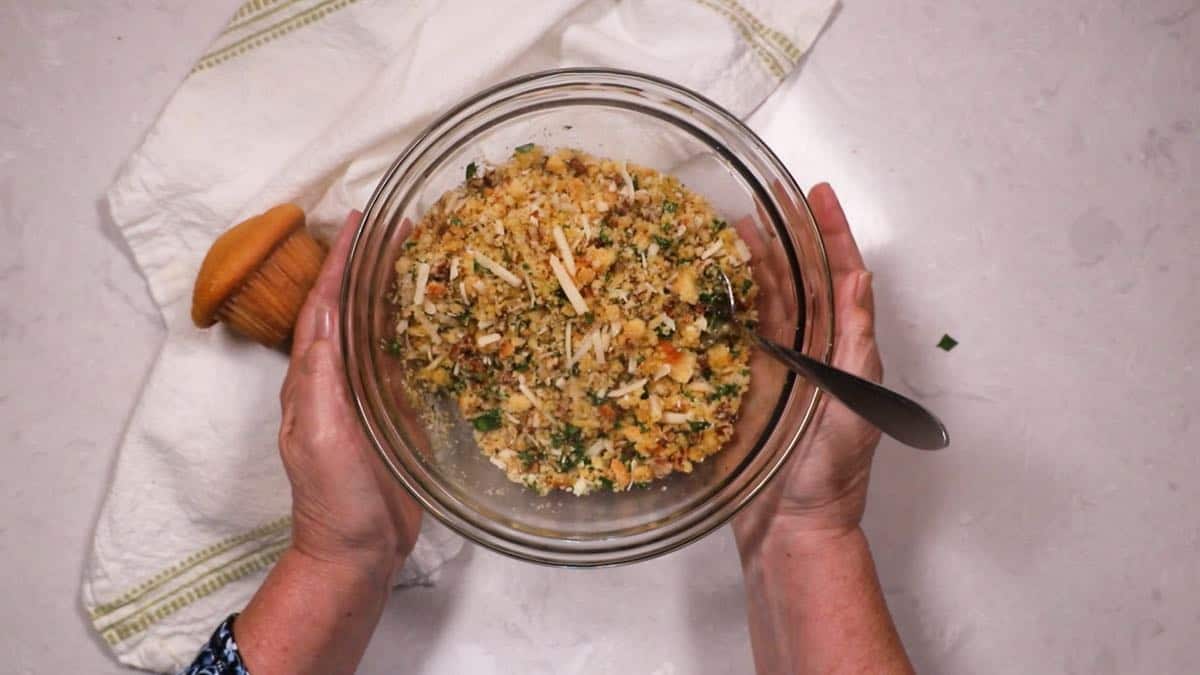
Place several spoonfuls of stuffing on top of each flattened piece of pork and roll up into a cylinder. Secure with two pieces of kitchen string. It's okay if some of the stuffing falls out.
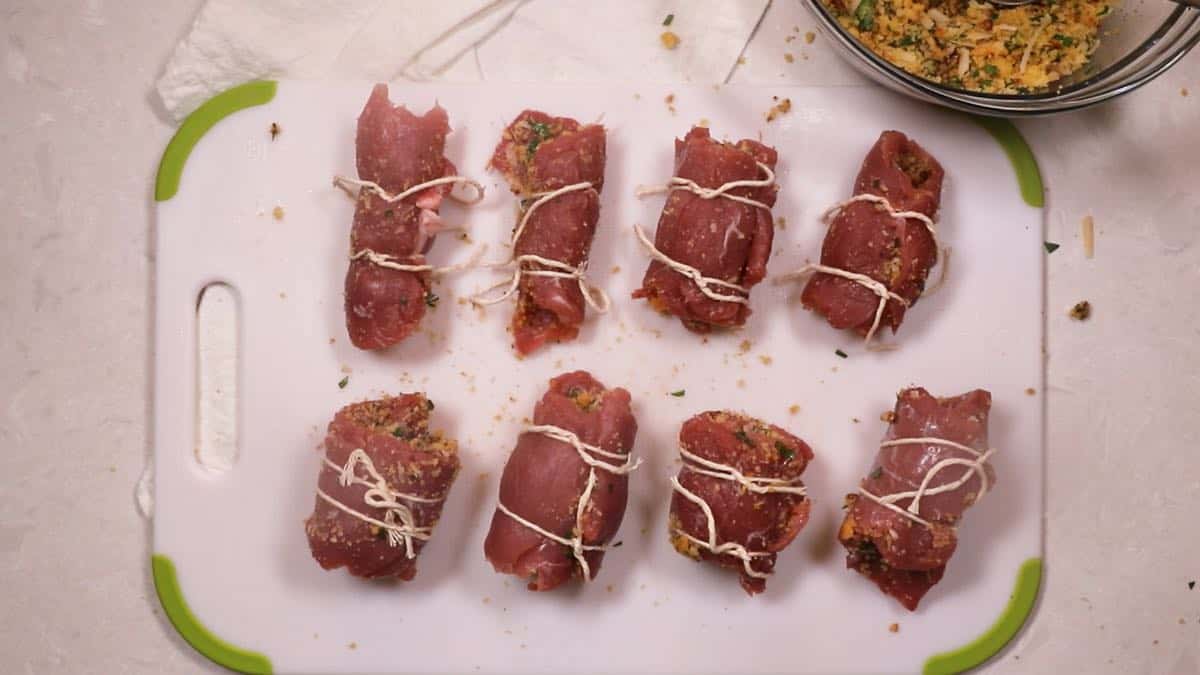
Add the flour, salt, and pepper to a shallow bowl. Use a whisk or fork to combine. Dredge each pork braciola in the flour and shake off any excess. Place the rolls on a wire cooling rack.

Add olive oil to a large skillet over medium-high heat. When the oil is hot, place four pork rolls in the skillet and brown about a minute on each side. Place the browned braciole back on the wire cooling rack and set aside. Repeat with the additional rolls. (They will not be fully cooked at this point.)
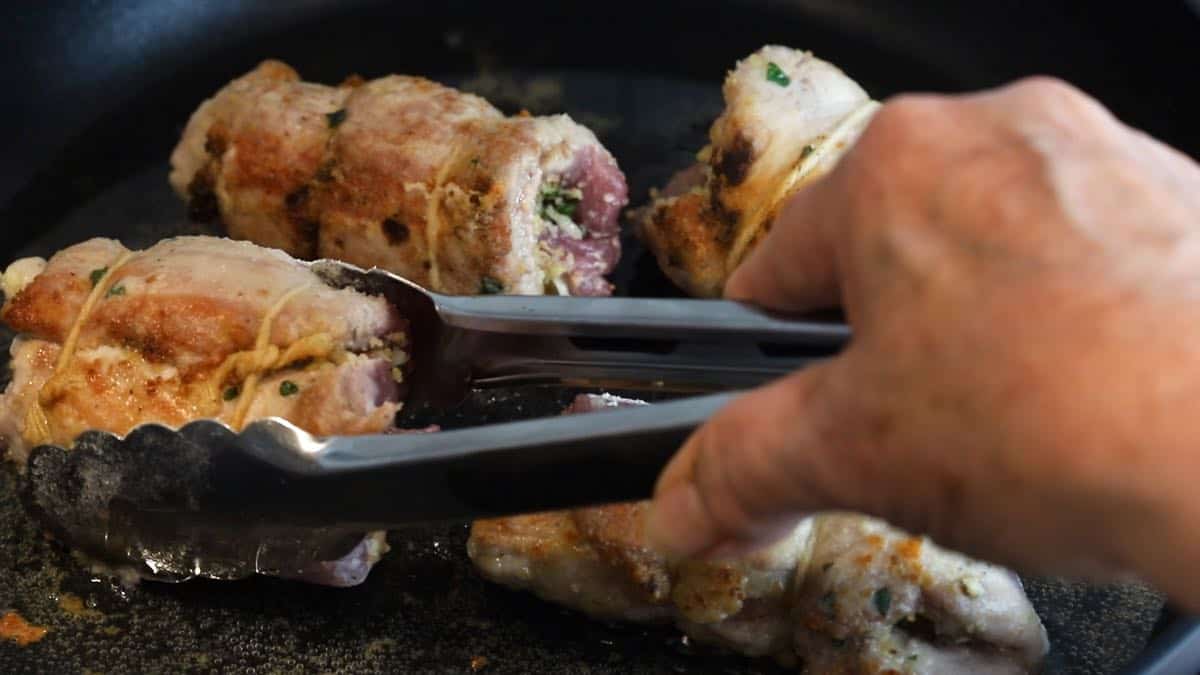
To make the marinara sauce, reduce the heat to medium and add the onions to the same skillet. Cook the onions for about five minutes or until they are tender and translucent. Add the garlic and cook for about 30 seconds. Then, add the tomatoes, basil, red pepper flakes, wine, and water.
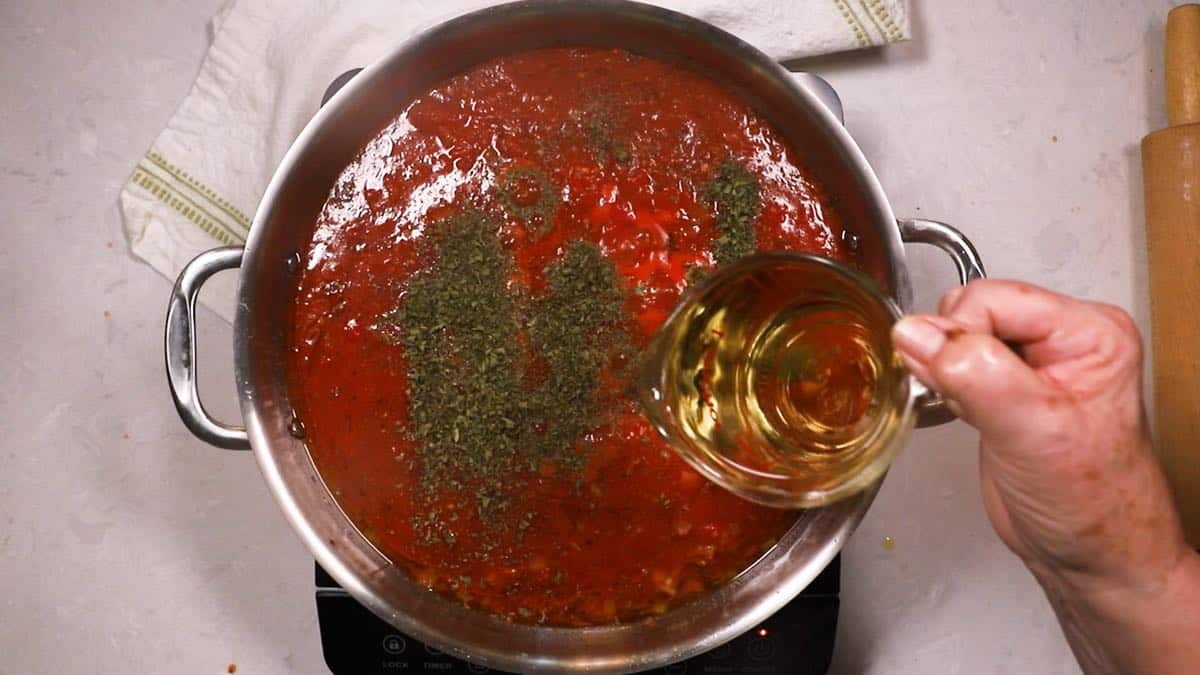
Use a potato masher or fork to break up the tomatoes and cook the sauce for about 30 minutes or until it has thickened.
Nestle the pork rolls in the sauce, cover, and cook in a 400-degree oven for 20 minutes or until the pork has reached 145 degrees as measured in the thickest roll by an instant-read meat thermometer. At about the ten-minute mark, turn the rolls over so they will cook evenly.
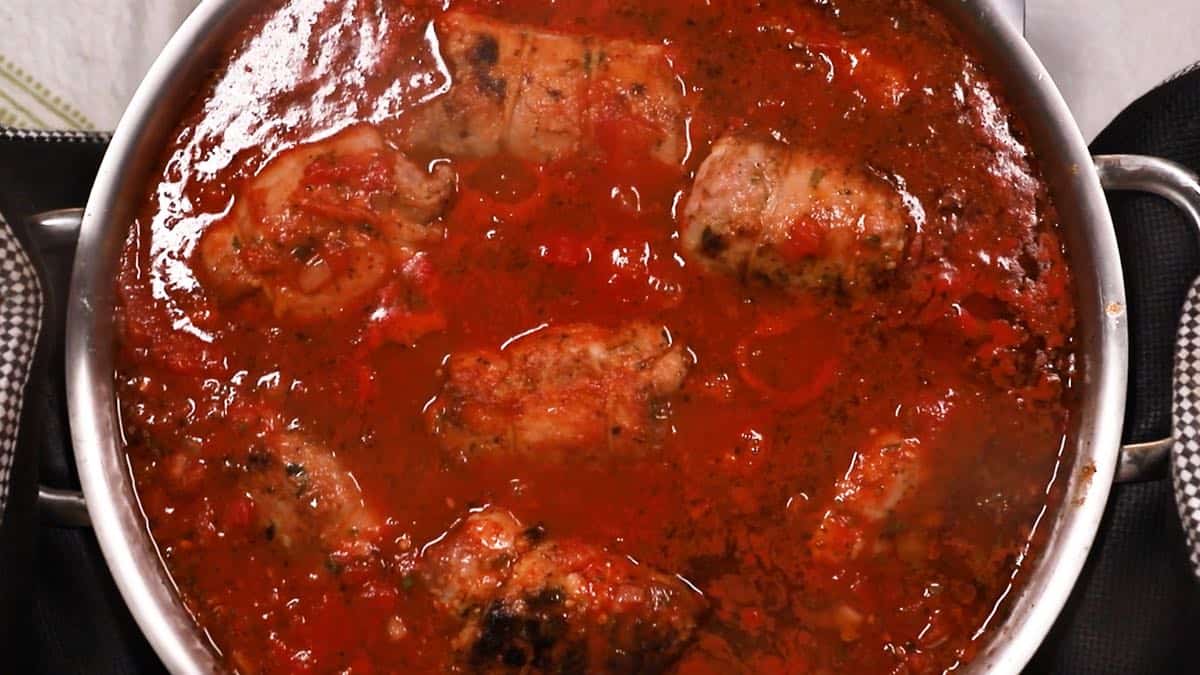
Remove the pan from the oven and let the meat rest for at least three minutes. The USDA recommended temperature for pork is 145 degrees.
Carefully cut the string on the rolls with kitchen scissors, and remove and discard it. Place the pork braciola on a platter and spoon the sauce over the top. Add chopped parsley, and optionally, grated parmesan cheese. Serve immediately.
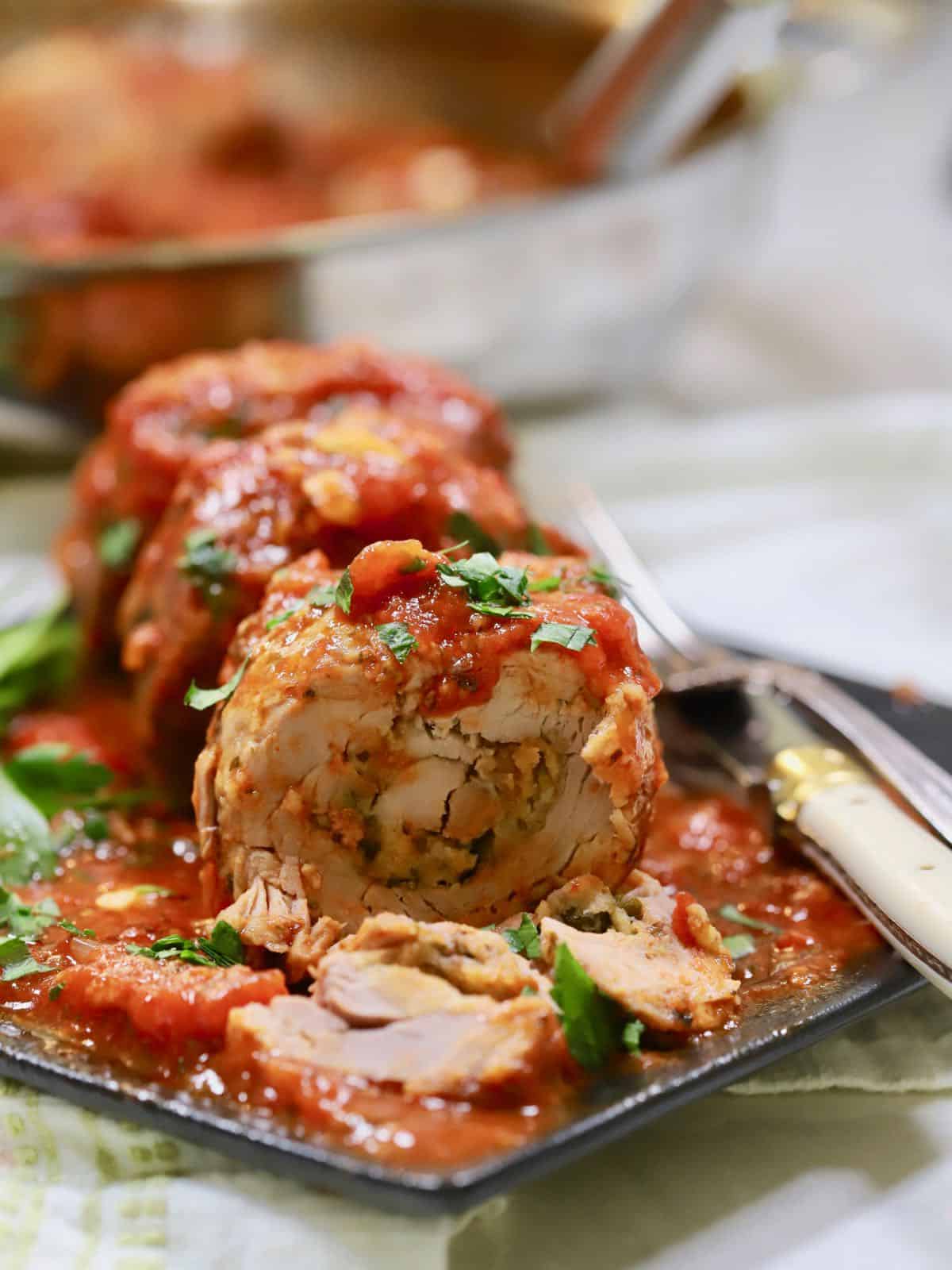
Frequently asked questions:
What to serve it with?
Because my recipe has a southern twist, I like to serve pork braciole with parmesan cheese grits. However, as you can imagine, it is also wonderful served over pasta or polenta. A side salad would round things out nicely.
How to make it ahead:
One of the best things about this recipe for pork braciole is that you can make all or any part of this dish ahead and store it in the refrigerator tightly covered for up to 24 hours before cooking. Or, you can store it in the freezer tightly covered for several months. If frozen, be sure to allow it to thaw in the refrigerator overnight before cooking.
Leftovers and storage:
Leftovers can be stored tightly covered in the refrigerator for up to four days.
Sharon's Tips:
When making the marinara sauce, many folks like to break up their tomatoes with their hands, but I prefer to use a potato masher or large fork. I usually leave my sauce fairly chunky.
Pork tenderloin is very lean, so it's important not to overcook it. It can quickly go from tender and juicy to dry and flavorless if it's cooked too long. Be sure to check the internal temperature and remove it from the oven as soon as the meat registers 145°F in the thickest part of the braciola.
Other cuts of pork, like thinly sliced boneless pork butt or shoulder, can be used instead of the pork tenderloin, but these cuts have more fat and connective tissue and will have to be cooked up to an hour and a half more or until they are tender.
You can certainly make your own cornbread, but purchased corn muffins make a great substitute if you don't have time to make your own.
To roast a small number of pecans, I usually place them on a microwave plate and microwave them for two to three minutes.
Related recipes:
If you are like me and like recipes featuring pork tenderloin, check out these other popular dishes on my blog:
- Bacon and Mushroom Stuffed Pork Tenderloin
- Oven Roasted Pork Tenderloin with Spicy Mustard Sauce
- Grilled Pork Tenderloin with Dark Cherry Sauce
- Grilled Pork Tenderloin with Peach Salsa
- Herb Crusted Roasted Pork Tenderloin
This recipe was inspired by the Beef Braciole recipe on the From a Chef's Kitchen Blog.
★ If you make this dish, please leave a comment and give this recipe a star rating. I would love to know how you liked it!
Thank you so much for visiting Grits and Pinecones!
Pork Braciole Recipe
A traditional Italian recipe but with a southern twist, this Pork Braciole is fork-tender medallions of pork tenderloin stuffed with a cornbread mixture and then simmered in a flavorful homemade marinara sauce.
Course Dinner
Cuisine Italian, Southern
Prep Time 20 minutes
Cook Time 1 hour
Total Time 1 hour 20 minutes
Servings 8 servings
Calories 414 kcal
- 2 pork tenderloins about one to one and a half pounds each
- ½ cup all-purpose flour
- 1 teaspoon kosher salt
- ½ teaspoon ground black pepper
- ⅓ cup olive oil
Stuffing
- 1½ cups cornbread crumbled, I used three cornbread muffins
- ½ cup parmesan cheese
- ½ cup roasted pecans chopped
- 2 tablespoons parsley dried
- 3 cloves of garlic minced
- 1 teaspoon kosher salt
- ½ teaspoon ground black pepper
- ¼ cup olive oil
Marinara sauce
- ½ cup onion finely chopped
- 5 garlic cloves minced
- 56 ounces San Marzano tomatoes 2 28 oz cans, whole with juice
- 2 teaspoons kosher salt
- ¼ teaspoon red pepper flakes
- 1 cup white wine
- ½ cup water
- 1 tablespoon dried basil
Optional Garnishes
- fresh parsley and grated parmesan cheese
-
Cut the pork tenderloins into eight equal pieces. Place each piece in a plastic storage bag and use a meat mallet or rolling pin to gently pound each piece to a 1/4-inch thickness. Set aside.
-
To make the stuffing, crumble the cornbread and place in a medium-size bowl. Add the parmesan, parsley, garlic, salt, pecans, and olive oil and combine.
-
Place several spoonfuls of stuffing on top of each flattened piece of pork and roll up into a cylinder. Secure with two pieces of kitchen string. It's okay if some of the stuffing falls out.
-
Add the flour, salt, and pepper to a shallow bowl. Use a whisk or fork to combine. Dredge each pork roll in the flour and shake off any excess. Place the rolls on a wire cooling rack.
-
Add olive oil to a large skillet over medium-high heat. When the oil is hot, place four pork rolls in the skillet and brown about a minute on each side. Place the browned rolls back on the wire cooling rack and set aside. Repeat with the additional rolls. (They will not be fully cooked at this point.)
-
To make the marinara sauce, reduce the heat to medium and add the onions to the same skillet. Cook the onions for about five minutes or until they are tender and translucent. Add the garlic and cook for about 30 seconds. Then, add the tomatoes, basil, red pepper flakes, wine, and water.
-
Use a potato masher or fork to break up the tomatoes and cook the sauce for about 30 minutes or until it has thickened.
-
Nestle the pork rolls in the sauce, cover, and cook in a 400-degree oven for 20 minutes or until the pork has reached 145 degrees as measured in the thickest roll by an instant-read meat thermometer. At about the ten-minute mark, turn the rolls over so they will cook evenly.
-
Remove the pan from the oven and let the meat rest for at least three minutes.
-
Carefully cut the string on the rolls with kitchen scissors, and remove and discard it. Place the braciola on a platter and spoon the sauce over the top. Add chopped parsley, and optionally, grated parmesan cheese. Serve immediately.
Because my recipe has a southern twist, I like to serve it with parmesan cheese grits. However, as you can imagine, it is also wonderful served over pasta or polenta. A side salad would round things out nicely.
One of the best things about this recipe is that you can make all or any part of this dish ahead and store it in the refrigerator tightly covered for up to 24 hours before cooking. Or, you can store it in the freezer tightly covered for several months. If frozen, be sure to allow it to thaw in the refrigerator overnight before cooking.
Leftovers can be stored tightly covered in the refrigerator for up to four days.
Many folks like to break up their tomatoes with their hands, but I prefer to use a potato masher or large fork. I usually leave my sauce fairly chunky.
Pork tenderloin is very lean, so it's important not to overcook it. It can quickly go from tender and juicy to dry and flavorless if it's cooked too long. Be sure to check the internal temperature and remove it from the oven as soon as the meat registers 145°F in the thickest part of the braciola.
Other cuts of pork, like thinly sliced boneless pork butt or shoulder, can be used instead of the pork tenderloin, but these cuts have more fat and connective tissue and will have to be cooked up to an hour and a half more or until they are tender.
You can certainly make your own cornbread, but purchased corn muffins make a great substitute if you want to save time.
To roast a small number of pecans, I usually place them on a microwave plate and microwave them for two to three minutes.
Calories: 414 kcal | Carbohydrates: 32 g | Protein: 18 g | Fat: 24 g | Saturated Fat: 5 g | Cholesterol: 56 mg | Sodium: 1555 mg | Potassium: 620 mg | Fiber: 4 g | Sugar: 10 g | Vitamin A: 390 IU | Vitamin C: 12 mg | Calcium: 134 mg | Iron: 3 mg
Please leave a comment below and/or give this recipe a rating. On Instagram? Take a picture and tag @gritsandpinecones or #gritsandpinecones!
How to Cook Pork Braciole in the Oven
Source: https://www.gritsandpinecones.com/braciole-pork-with-a-twist/
0 Response to "How to Cook Pork Braciole in the Oven"
Post a Comment